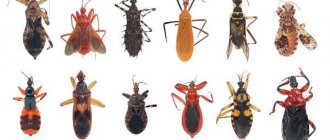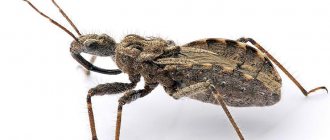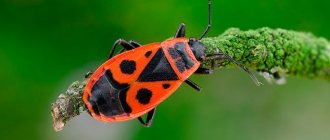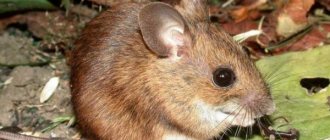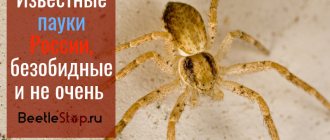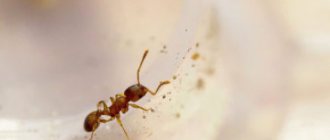Appearance of a bedbug
Reproduction of bed bugs
House bug bites
Types of bedbugs
Everything about bedbugs is information worth reading. Bed bugs, aka sofa bugs, and house bugs are one of the oldest creatures on the planet. They quickly adapt to environmental conditions, multiply rapidly, and develop resistance to poisons.
Who are bedbugs? What they look like. Which class do they belong to? Description, class structure
Insects are united by the order Hemiptera. Classification:
- kingdom - animals;
- phylum – arthropods;
- suborder - bedbugs.
Pests are insects with an incomplete development cycle (transformation). This means that they skip one of the stages of formation (in particular, pupation) and go straight to the next one - a larva emerges from the eggs. There are about 40,000 species of individuals. They are divided into 50 families. Representatives of each species have characteristic external features that make them stand out from the rest. Garden ones have a bright color, water and indoor ones have a discreet appearance.
There are a number of common features common to most bedbugs:
- 3 pairs of legs;
- 1 pair of antennae;
- hard shell;
- oval body shape.
Many types of bedbugs have wings and can move long distances, while others (the smallest) fly with the wind. There are also those that do not have wings or that have reduced outgrowths. The body size of creatures of different species is also different in each case. There are individuals less than 1 mm and more than 15 cm in length. The mouthparts are of the piercing-sucking type, with a noticeable part being the proboscis.
Different life stages of bed bugs
What types of bedbugs are there?
Representatives of the suborder bedbugs (Heteroptera) lead a terrestrial and aquatic lifestyle. Insects are predominantly small and medium sized. Giant water bugs, reaching a length of 15 cm, especially stand out against their background. The common body shape is flattened, some species are close to a ball, some are rod-shaped. Insects share common morphological characteristics:
- The structure of the oral apparatus - the lower lip has changed into a proboscis, the upper and lower jaws have turned into piercing bristles. The piercing-sucking type is designed for the consumption of liquid food. The jointed proboscis can contract and stretch. There is a groove on the chest for its placement. There are two channels inside the organ, one of which delivers food enzyme (saliva) to the puncture site, the second one pumps out liquid food.
- The presence of odorous glands - on the chest of insects there are appendages that secrete a special secretion. The sharp unpleasant odor of liquid from the glands scares away potential enemies. By studying the chemical composition of the substance, scientists established its similarity to pheromones.
- Type of wings - in representatives of the order Hemiptera, half of the fore wings are leathery or chitinous. The remaining margin and hind wings are membranous. In some species the flight organ is completely reduced, in others only the elytra are preserved.
- Number of limbs - all bedbugs have 3 pairs of legs. Their structure depends on their habitat. Aquatic species have swimming limbs, while land species have running limbs.
How many types of bedbugs live on our planet? Wikipedia answers this question - about 40 thousand species. They differ in size, shape, and body color. Most of the insects received a protective coloring of grayish, brownish and greenish shades. But representatives of the superfamily shieldfish are yellow, blue, and red. Modest coloring characteristic of vulnerable insects. Individuals with bright colors usually have potent secretions; the article “How to recognize a stink bug and get rid of the pest?” will tell you about such insects.
Bedbugs have well-developed senses of touch; in addition to the antennae, there are sensitive hairs on the body. Some species are endowed with excellent vision. They have convex compound eyes complemented by simple ocelli.
Information. Organ reduction is associated with lifestyle features. Aquatic species do not have scent glands, and parasites do not have wings.
Nutritional Features
Types of bedbugs are classified according to their feeding method. Among them are:
- Herbivores or phytophages make up the bulk of the species. Adults and nymphs feed on the cell sap of various parts of plants - leaves, fruits, seeds. Many bugs are pests of field, garden and ornamental crops. The greatest danger is posed by quarantine species; one of them will be discussed in the article “Dangerous pest of gardens and fields: how to deal with the marbled bug?”
- Predators – attack invertebrates, insects and their larvae. The proboscis of bedbugs is shortened and durable, resembling a beak. The families of predators include: hunting bugs, most aquatic species.
- Parasites are hematophagous - insects feed on the blood of people and warm-blooded animals. Representatives of ectoparasites mainly live in houses, but some are found in natural conditions.
Information. Some species are characterized by a mixed diet (herbivory and predation). Cannibalism is common among bedbugs.
Representatives of the laceweed and earthen shield families are able to live together with ants, and individuals of the Termitaphididae family get along with termites. Some horseflies and predators settle in the web, where they feed on prey caught in it.
Bed bugs are natural helpers
Such insects feed on other creatures. To get enough, they attack garden or vegetable pests, which allows them to control the number of the latter. For this reason, insects of this group are considered assistants to people.
The bug Podius maculiventris eats the Colorado potato beetle
These are individuals of the family of true shield insects, therefore they have all the characteristics: a wide pentagonal green shell, multi-segmented antennae, the length of the pests is 11 mm, but the females are larger. The insect destroys many varieties of fellow insects (about 90 species) on the site, most of which harm agricultural crops. Due to this, Podius maculiventris is considered beneficial.
The moment a bug attacks an adult Colorado potato beetle
Anthocoris nemorum
Externally, such pests differ significantly from their counterparts in other families - they are characterized by a marbled color (chitinous covers in white and light brown tones). The body is narrow, the antennae are much longer, the head and chest are black.
Street bugs of this species feed on small pests: aphids, cicadas, thrips, and other insects.
Anthocoris nemorum
Predatory bugs of the genus Orius and Anthocoris
They are small in size (no more than 3 mm). They destroy pests of various crops, including flowers. Such insects can be grown in artificial conditions to control the number of thrips, aphids, coccids, and whiteflies. In addition, pollen is used as fertilizing. But control of the number of Orius and Anthocoris insects is also required, taking into account the area (it is recommended that the population be no more than 2 individuals per 1 sq. m.).
Bugs of the genus Orius
Family of predators (Reduviidae)
Representatives of this group of insects do not have the characteristic signs of bedbugs. They have a large body, long antennae, the color is often inconspicuous (black, brown), less often interspersed with bright dots and spots (green, yellow, red, orange). Another significant difference is the constriction of the pronotum, dividing it into a narrower and wider part. This group includes different types of bugs: predators, parasites. The former feed on insects, the latter on blood. Predators are more common in Europe, America, and Africa.
Reduviidae
Macrolophus (fly family Miridae)
Such street bugs are represented by different types; body length varies from 2 to 11 mm. The shape of the parasite is different: oval or more rounded. The outer integument is less rigid than that of representatives of other species. Among horseflies there are many herbivorous bugs. Some are zoophytophages and also accept animal food.
Miridae
Parasitic pests
They are also called blood-sucking. They feed on the blood of living creatures, mainly people. Many species affect small and large animals and birds.
House bug, also known as bed bug
The parasite drinks human blood. He settles nearby, strives to build a nest inside the sofa, bed, so in the morning many bites are found on the body. This is a domestic bug; it is extremely rare on the street and usually not of its own free will. The main danger is the risk of developing allergies after contact with it, since at home a significant amount of excrement, chitin particles and other waste products of parasites enter the air.
When bitten, a special secretion enters the human body, which also causes a negative reaction.
Bed bug
Kissing bug (triatomine)
This is a representative of predators. A street bug that feeds on blood. Such insects attack people, their bites are accompanied by severe pain. The main danger is the risk of developing Chagas disease (resulting in death). The bug is characterized by its large size - up to 3.5 cm. Depending on the species (there are 130), the body color varies from black to brown.
kissing bug
Taste preferences
House bug bites
The insect is a parasite of humans. Bed bugs feed only on blood. The victim is found by the smell of carbon dioxide, which is released when a sleeping person exhales. Blood not only replenishes vital energy, but is also a trigger for the next stage of development in nymphs, the laying of eggs in adult adults. Before each process, a new portion of food is needed.
On a note!
In an emergency situation, when there is a question of life and death, a bedbug may covet the blood of an animal, but such nutrition will be incomplete. The domestic parasite will not have the opportunity to develop further or lay eggs.
Pests of our beds
This group includes pests that live on plants, feed on plant sap, and reproduce here. They are not found at home; they can only get into human habitation by accident.
Pests of this species usually do not survive indoors, especially where there are no plants.
Cabbage bug
This is one of the most dangerous pests of the cruciferous family. Bugs puncture plant tissues and suck out sap. These areas have necrotic spots (yellow). Severe damage may reduce yields. This type of bug is called evidema. The body length is 1 cm, the color is bright, somewhat reminiscent of the well-known soldier (black and red), but the pattern on the back is different.
Cabbage bug
Rapeseed bug
This is a representative of the shield family, distinguished by its bright color (black and yellow). Body length varies from 6 to 9 mm. The bug is found all over the world. It poses a real threat to plants of various types (mainly cruciferous crops). It affects radishes, rutabaga, cabbage, turnips, etc. The greatest danger is posed by the larvae - they emerge from eggs immediately on the leaves and begin to destroy them.
Rapeseed bug
Light green stink bug
Its other name is also known - woody. Belongs to the family of true shield insects. It reaches 16 mm in length, the body shape resembles a shield (pentagonal), which influenced the name. Due to the color of such insects it is difficult to see on plants (the shell is green). Pests lay eggs here. They are also green. These types of bugs are found in gardens and plantations; they infect deciduous trees and shrubs.
They prefer raspberries, but can also feed on cereal plants.
Light green stink bug
Lined stink bug
Another name is graphozoma or Italian parasite (the color resembles the colors of the attire of the Vatican guards). The length of the pest is 11 mm. The body color is red, longitudinal stripes are visible on the shield. The insect is found in Russia, as well as in regions throughout the middle zone and Asia. The food source distinguishes these bugs from others - they feed on the seeds of umbrella crops.
Lined stink bug
Harmful turtle
Such pests belong to another family - shield turtles. They have many similarities with shield insects, for example, body shape, length (11-13 mm). However, there are also differences. The corners of the shell are more rounded. These are flying insects; they can travel up to 200 km in order to change wintering sites (forests and gardens) closer to habitats in the warm season (fields). They develop quickly, which allows 3 generations to appear in 1 season.
They feed on cereal plants.
Harmful turtle
Berry bug
This is a bright pest, it is distinguished by a yellowish, brown or reddish color, the shield is partially colored with black punctures on the sides. They do not have clear feeding habits; such insects are polyphagous - they are found on fruit, berry, garden, and grain crops. Oilseeds, industrial plants and even ornamental plants are affected.
Berry bug
Bedbugs are parasites
Parasitic type bedbugs are blood-sucking insects that settle closer to people. The danger is that they can carry infectious and viral diseases.
Bed sheets
Bed bugs are the main species of house bugs that feed exclusively on the blood of mammals. They often live in the sleeping areas of humans and pets. When in danger, they emit an unpleasant bug odor.
Cimex lectularius
It is a wingless, flat-shaped insect. Adults reach a size of up to 8 mm. The exoskeleton of a hungry parasite is dirty yellow or brown. After saturation with blood, it changes color to black or dark red.
The eggs of the parasites resemble small grains of rice - up to 1 mm in length. Painted white. Due to the content of a specific secretion produced by internal glands, when crushed, eggs emit a sharp, unpleasant odor.
Attention! Types of bed bugs appear regardless of the sanitary condition of the apartment.
Cimex adjunctus
Alternative names: white, mouse bug. It feeds on the blood of bats and rarely lives in human bedding. In appearance it does not differ from Cimex lectularius. The length of the body is from 3 to 8.5 mm, depending on the degree of saturation of the parasite with blood. Females are larger than males. A distinctive feature of a mouse bug is the presence of white hairs near the head. Insects do not have fore or hind wings.
Cimex hemipterus
The bug Cimex hemipterus is a blood-sucking insect. Parasites prefer to settle closer to people. They actively displace the bugs Cimex lectularius, with which they are similar in appearance. Distinctive features are thinner, elongated limbs and a less rounded body. With the onset of dusk, the activity of parasites decreases. They are highly resistant to chemical insecticides.
Oeciacus
An alternative name is the swallow bug, which parasitizes the bird species of the same name. The rounded body is painted white. Distributed in the European part of Russia.
Triatomine bug (Triatominae)
Belongs to the family of carnivores and is nocturnal. The insect has an elongated body, about 2 cm long. The exoskeleton is black or gray, with orange or red spots on the sides. Adults have hard wings and 3 pairs of limbs. On the cone-shaped head there are long antennae and a piercing-sucking mouthparts. The parasite's diet includes only the blood of mammals and birds. The proboscis is sensitive to infrared radiation.
An alternative name is the kissing bug, because its mouthparts are not capable of piercing the thick skin of the body. To suck blood, the insect bites a person in the soft tissues of the eyes and lips.
Important! The triatomine bug is one of the most dangerous types of parasite, as it can infect humans with Chagas disease or American trypanosomiasis.
Chicken bugs
The insects resemble chicken mites in appearance. They are brown in color and have a flattened body. They swell from drinking blood and change color to black or burgundy. They are nocturnal and hide in hard-to-reach crevices during the daytime. You can suspect the presence of parasites in birds by skin irritation and redness. Bedbug bites cause severe itching and pain, which is why the bird begins to peck at the affected area and injure itself with its claws.
Harmless representatives
There are also non-dangerous insects of the order Hemiptera. They exist next to predators and herbivores, but do not crawl into people's homes. For these reasons, no one fights such insects; the number of their colony may decrease by chance if they find themselves near the place of persecution.
Soldier bug
These are representatives of red bugs; they are distinguished by their medium size (about 11 mm) and the black-red color of their outer covers. Insects have eyes, they are also red. They can feed on other pests, as well as plants, for which a proboscis is provided - the visible part of the piercing-sucking mouthparts. They live on tree trunks, stumps, and grass.
Soldier bugs
Alder bug
This is another type of wood stink bug. Insects live on alder trees, and here they leave their offspring. The peculiarity of this species of bedbugs is that the females do not leave the nest and the larvae until they acquire the skills to survive independently. These insects do not cause any harm to crops grown by humans.
Alder bug
Garden pests
So, we found out that most bedbugs harm agriculture and crops useful to humans. Now let's find out which of them are the most dangerous? Bug bug, another name for “harmful turtle.” This type of bugs once caused enormous damage to agriculture on a national scale.
On a note:
Harmful turtles feed on seedlings of grain crops and wild grains. All grain crops are damaged, most severely wheat.
The turtle bug is so named because of the characteristic “tortoiseshell” pattern on its back. It is noteworthy that not only cereals, but also fruit and berry plants can suffer from this bug. Another type of bug that causes enormous damage to garden crops is the so-called cruciferous bug, which is scientifically called “Eurydema northern.”
It is red and black in color and looks similar to the common red and black soldier bug that is very often seen underfoot in rural areas. His photo is below
In fact, the cruciferous bug and the soldier bug, despite their similar color, are representatives of different types of bugs. And if the soldier bug does not cause visible damage to agriculture, then the cruciferous bug is not averse to eating vegetable crops, such as radishes, cabbage, etc. Other pest bugs include the pear bug, which feeds mainly on the foliage of fruit plants (see photo);
cucumber bug, which is very small in size and feeds mainly, as the name suggests, on cucumber leaves (see photo);
the berry stink bug, or stink bug, mentioned earlier, which causes great harm to berry bushes;
Horsefly bug, which can cause damage to almost all types of plants (see photo)
In general, pest control occupies a significant part in the theory and practice of farming.
Bedbugs are water lovers
Representatives of this species prefer to live in an aquatic environment. Many of them have wings and can migrate between bodies of water. Another feature of representatives of this species is their large body size.
Water scorpion
There are many species, but most are concentrated in tropical regions. The body length of the pest is 2.5 cm. It is distinguished by large forelimbs and a breathing tube at the end of the body. Such bugs move little and spend most of their time in ambush, which is why they are also called hunters. Excellent results in searching and catching prey are achieved not only thanks to the grasping limbs, but also with the participation of the organs of vision and senses.
The bug feeds on larvae, tadpoles, and sometimes bites a person (a forced protective measure).
Water scorpion
Belostoma gigantea
This insect is much larger than the others. The body length reaches 17 cm; the bug can be found in the tropics and regions with temperate climates. The forelimbs, like those of the water scorpion, are somewhat reminiscent of claws. They provide a secure grip on the victim. Belostoma feeds on small creatures (insects, crustaceans, amphibians). Spends most of its time under water, but is also found on land - mainly during resettlement.
Belostoma with a clutch of eggs on the back
Plautus vulgare
This insect is medium in size - 1.5 cm. It is distinguished by its bright color - there are green and yellow shades on the brown shield. This is a predatory insect, found everywhere except in the Northern regions. But most species of such bugs live in the tropics. Unlike its counterparts, which move little but hunt a lot (water scorpions, belostoma), the swimmer has excellent physical characteristics - a streamlined body, the structure of the limbs allows it to move quickly in the water.
In addition, the bug crawls well underwater on plants and can fly.
Plautus vulgaris, also known as the “diving beetle”
Description, structure, types
Bedbugs, depending on the species, can have sizes from 1 mm to 15 cm, and as is often customary in nature, females are larger than males. The largest bugs are Belostomatidae (water bug), reaching 15 cm in size and living in the tropics. The varied body shape of an insect depends on living conditions:
- Flat bugs are parasitic bugs, bed bugs that live in our homes.
- Globular - have representatives of earthen and desert species.
- Rod-shaped - a rod-shaped predator native to South America.
- Tortoiseshells - they are also called harmful turtles.
Beneficial bugs
Such individuals do not harm crops, but destroy harmful insects. For the most part, this group includes predators. They kill insects by injecting a substance that liquefies soft and hard tissue.
Arma is predatory
This is a representative of the shield family, body length - 14 mm. The bug is characterized by a discreet color (brown). It has a flat body with a hard shield. The insect damages the integrity of the external integument of the pests, injects a substance containing an enzyme, and then sucks out the juices. It feeds mainly on caterpillars.
Arma is predatory
Zicron blue
This is a small street bug. The body length is 5-8 mm, the color may vary, but blue shades are always present. The bug destroys the offspring of the Colorado potato beetle, as well as other pests, such as leaf beetles. It lives in trees, but is also found in grass.
Zicron blue
Perillus – Perillus bioculatus
The insect is brightly colored (black back, red pattern). Body length – up to 12 mm. Some time ago, the habitat of the bug was much narrower - limited to the Nearctic. Today, insects of this group (the family of shield insects) are found even in Europe. Their food source is beetles (arthropods), mainly larvae.
Perillus bioculatus
Parasitic species
The bedbug has about a hundred species, is distributed throughout the world and feeds exclusively on the blood of humans and animals. It lives in our homes, but is also found in caves inhabited by bats. It has no wings, but has a very good sense of smell, which helps determine the location of blood vessels. Often, if a bug has a choice between an adult and a child, the child will be bitten. The danger posed by bedbug bites is allergies, itching and general psychological condition.
The kissing bug (triatomine) - behind its romantic name, carries a mortal threat. They are carriers of Chagas disease, a parasitic infection that can only be cured in the early stages of infection. Inhabitants of South America and Argentina, they live in rodent burrows and can fly.
How to get rid of uninvited guests in the house. Types of pest control chemicals
If there are blood-sucking insects in your home, you need to get rid of them as quickly as possible. Such pests are susceptible to chemicals - insecticides. Poison is delivered to habitats in different ways:
- aerosols are popular due to their high efficiency, such preparations are sprayed over all surfaces (except woven products), the death of pests occurs in a few minutes/hours;
- concentrated liquids - used to prepare a working solution, it is important to follow the recipe, the ratio of insecticide and water must not be violated, this may cause a decrease in the effectiveness of the product;
- crayons - applied to surfaces where insects usually are: along baseboards, on furniture frames, back walls of cabinets, chests of drawers, paintings, photographs;
- powders have the disadvantage of being able to treat only horizontal surfaces; in addition, preparations in this form do not allow full use of furniture and objects - particles are carried everywhere;
- hot and cold fog are relatively new types of products, sprayed using special equipment, which releases a fine suspension that remains in the air for a long time;
- smoke bombs are the most toxic method; according to the principle of action and structure, the released substance resembles a gas - the insecticide particles are so small that they penetrate everywhere.
Fog is considered one of the effective methods against bedbugs.
Signs of the presence of bedbugs in the house
It is hardly possible to detect insects as soon as they appear. Linen bugs are nocturnal hunters. During the day they hide in furniture, mattresses, and cracks in walls. At night, the parasites go out hunting, accurately determining by thermal radiation where the prey is located.
Often the insect moves along the ceiling, hovering above the sleeping person in bed and falling from there onto the skin. At first, when a person sees a bite in the morning, he thinks that he was bitten by a mosquito. When the population has grown, it is no longer possible not to notice the aliens.
The main signs of bed bugs appearing in a house:
- the bites are not single, but form a trail of small wounds;
- around the bug puncture on the skin a swelling forms with a lump in the center;
- toxins injected by insects into the blood of a sleeping person cause a typical allergic reaction in the form of burning and itching;
- Tiny blood stains often remain on the bed;
- places where insects accumulate (often under wallpaper on the walls) are contaminated with their excrement in the form of microscopic black dots;
- Pests can also be detected by the remains of the quinine coating, which they shed during molting;
- bedbugs have a specific smell - some call it cognac, while others think it is the aroma of rotten raspberries.
Expert advice
Marinina Evgeniya Vitalievna, entomologist, work experience – 16 years:
Marinina Evgenia Vitalievna
Entomologist, researcher. Work experience 16 years.
• to understand what kind of insect has been detected, you should pay attention to the living conditions; almost all types of domestic bugs live on the street or in non-residential buildings, with the exception of the bed parasite; • not all blood-sucking bugs prey on humans; some bite people for protection if they happen to be nearby; • There may be different types of outdoor bugs in an apartment, but only a few are able to survive there - representatives of families that feed on ornamental plants.
